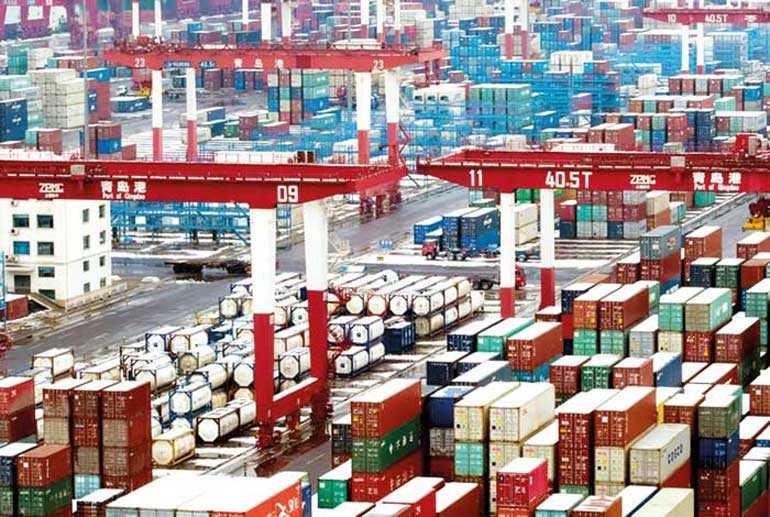Sunday Apr 20, 2025
Sunday Apr 20, 2025
Wednesday, 15 January 2020 00:04 - - {{hitsCtrl.values.hits}}

Containers and trucks are seen following a snowfall at the port of Qingdao, Shandong province, China February 14, 2019 - Reuters/File photo
BEIJING (Reuters): China’s exports rose for the first time in five months in December and by more than expected, signalling a modest recovery in demand as Beijing and Washington agreed to defuse their prolonged trade war.
The world’s largest economies are set to sign a Phase 1 trade deal on Wednesday, marking a significant de-escalation but not an end to a dispute that has rattled financial markets and threatened to derail global economic growth.
After a rough year, China’s exports ended 2019 on an upbeat note, rising 7.6% in December from a year earlier, customs data showed on Tuesday. The median forecast from a Reuters poll of analysts had been for a 3.2% rise in shipments, following November’s 1.3% drop.
Imports also beat expectations, jumping 16.3% from a year earlier, though boosted in part by higher commodity prices. The Reuters poll had forecast 9.6% growth versus 0.5% in November.
While comparisons with a weak December last year flattered both figures, they also pointed to improving demand, both globally and within China, analysts said.
China posted a trade surplus of $ 46.79 billion in December, compared with the poll’s forecast for a $ 48 billion surplus and up from November’s surplus of $ 37.93 billion.
For all of 2019, its total exports proved remarkably resilient to trade tensions, rising 0.5%, though that was well off a near 10% gain in 2018, reflecting weaker US sales.
Imports fell 2.8% last year as China’s economic growth cooled to near 30-year lows, after rising 15.8% in 2018.
China’s better-than-expected trade numbers come amid a flurry of trust-building gestures from both sides ahead of the signing of the Phase 1 deal.
The US Treasury Department said on Monday China should no longer be designated a currency manipulator – a label it applied as the yuan currency dropped in August.
On Tuesday, China’s customs vice minister Zou Zhiwu told a briefing that its soybean and pork imports from the US rebounded significantly in December and positive trade sentiment has boosted companies’ confidence.
But overall growth in imports from the US saw less of a pick-up than shipments from other countries in December, analysts from Capital Economics said in a note.
China’s trade surplus with the United States for December stood at $ 23.18 billion, according to Reuters calculations based on customs data, down from November’s surplus of $ 24.60 billion.
China exports to the United States fell 12.5% in 2019, compared with a rise of 11.3% in 2018. Imports from the United States fell 20.9%, versus a 0.7% rise in the previous year.
Overall sentiment improved last month after the two sides reached the Phase 1 deal, which is expected to cut tariffs and boost Chinese purchases of US farm, energy and manufactured goods while addressing some disputes over intellectual property.
Beijing has pledged to buy nearly an additional $ 80 billion of US manufactured goods over the next two years, plus over $ 50 billion more in energy supplies, according to a source briefed on the deal.
But companies remain cautious. US tariffs on $ 370 billion worth of Chinese imports will remain in place, and memories are fresh of a breakdown in an apparent deal last May which triggered a series of series of tit-for-tat tariff escalations.
The Phase 1 deal “stops the bleeding” but does not end the trade war, a senior US Chamber of Commerce official said on Monday, warning that significant challenges remain.
Analysts say the risk of further complications and re-escalation remains.
“Our judgment is Phase 1 will not put an end to Trump Trade Wars,” analysts with MUFG Bank wrote in a research note prior to the data.
Moreover, global demand is expected to remain soft this year, offering Chinese exporters only modest relief.
“The effective tariff reduction from the Phase 1 deal is fairly small, so any bounce in exports may not be terribly exciting...” ING economists said in a note before the data on Tuesday.
“The bottom line (is) China’s trade circumstances are still relatively weak, and the tariffs much higher than they were 18 months ago. We should not expect miracles.”
Oxford Economics believes US-China trade could stay depressed for years.
Rising Chinese imports of raw materials, meanwhile, are adding to signs that domestic demand may turning the corner after nearly two years of government growth boosting measures.
Unwrought copper imports rose 9.1% in December from the previous month to their highest since March 2016, while iron ore imports were the highest in 27 months.
Manufacturing activity in China, the world’s biggest copper consumer, expanded in December as signs of progress in trade talks boosted factories’ output and order books.
China’s crude oil imports in 2019 surged 9.5% from a year earlier, setting a record for a 17th straight year.
But it is still too early to say there has been a marked pick-up in its domestic demand, as the overall import growth figure comes off a weak December last year and was helped more by higher import prices than higher volumes, said the analysts at Capital Economics.
While the outlook for exports is improving, domestic demand will remain subdued, they said.